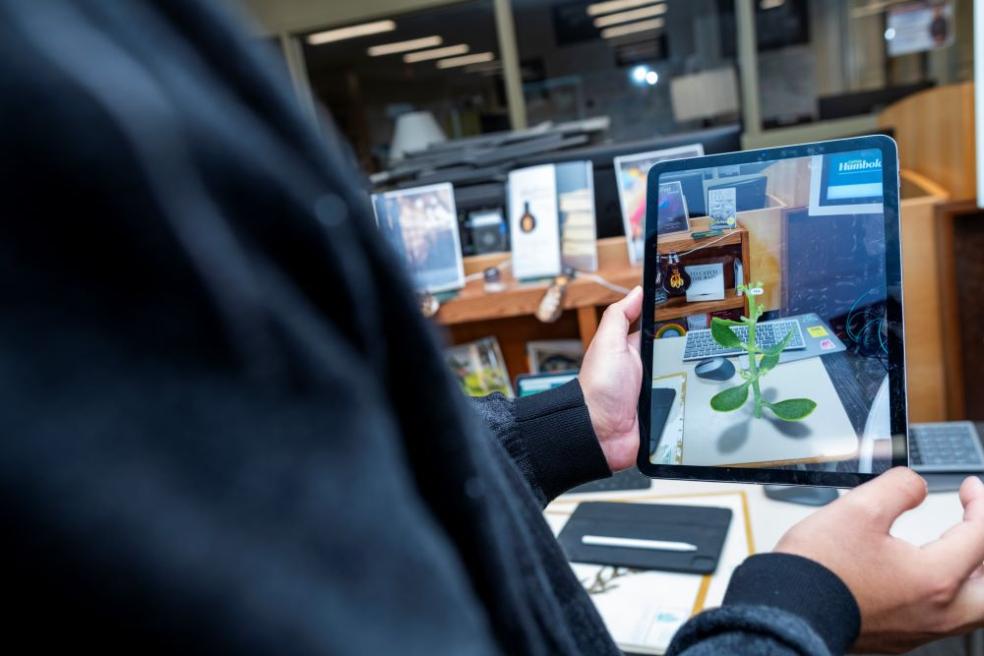
“This award recognizes the importance of student project-based learning and the impact of collaborative innovation with students, the campus community, and the world. Co-creating new powerful learning environments is a role we are very familiar with; libraries have always connected authors and readers to provide access to information, foster curiosity, and inspire learning,” says Library Dean Cyril Oberlander.
Established in 2019, the Emerging Technologies Section’s (ETS) Best Emerging Technology Application (BETA) Award offers $3,000 to an individual or group to recognize a technology application that directly benefits library users. The award is sponsored by Chatstaff and LibraryH3lp and will be used to hire botany and computer science students for assistantships to continue building the 3D Digital Herbarium at the Library. The interdisciplinary aspect of this project tremendously benefits students, as does the opportunity for botany students to write and publish annotations that share their knowledge of plant science worldwide, and computer science students to write code that enhances learning worldwide.
“The committee found 3D Digital Herbarium to be an innovative method for advancing the work of herbariums through 3D imaging. The committee found the site easy to use, accessible, and, most importantly, engaging for the viewer and also the students involved. They were also impressed with the impact it has had on the Cal Poly Humboldt community and its great potential to advance herbarium scholarship and engagement, as well as to create new partnerships for the Cal Poly Humboldt Library,” notes the Award Committee Statement.
The project uses immersive technology to create interactive 3D models of local flora that enable users to visualize, identify, and learn about plants, including their habitats and life cycles. The images and data are condensed into an easy-to-use package that's free and open to everyone.
Cal Poly Humboldt Library launched the 3D Digital Herbarium with a campus community celebration in January. This project showcases the vibrant learning environment of the Library, connecting people and ideas, and curating collaborative innovation.
The project started in the Fall of 2022 when Computer Science students AJ Bealum, Jordan Sanchez, Kevin Fasteen, and Michael Gonzalez—who called themselves Team Flora—accepted the Library’s project challenge to build an interactive botany kiosk. They successfully built a prototype in 14 weeks, which was a strong foundation for the 3D Digital Herbarium.
In January of 2023, the Library hired Bealum, one of the original Team Flora members, as the Library’s programmer and project manager, and later hired additional Botany and Computer Science students to mature the prototype into an extraordinary Version 1 open-source software encompassing more than 40 3D models.
Heather Davis, Botany major and Team Flora member, shared that the project’s experiential learning process is particularly exciting, “As a scientist, I think it's a fun project to think about the engagement that it can have with students and being able to teach them about cataloging plants and getting them engaged with our local flora.”
The rapid pace of the software’s development involved extensive research and experimentation with photogrammetry and 3D modeling for what proved to be difficult objects to model: highly complex plants with many 2D flat leaves. This outstanding team persevered and successfully developed new protocols to create immersive real-life representations of plants, while the Library’s botany student assistants annotated the specimens, making science more accessible to learners worldwide.
Team Flora continues building models, adding annotations, and developing new interactive features. They recently started to collaborate with Cal Poly Humboldt’s Vertebrate Museum. Their 3D model of the articulated skeleton of a flying squirrel uses the 3D Digital Herbarium as a starting point for an unparalleled curated interactive exhibit for any discipline.
“Today, learning and connecting people and ideas adds an immersive digital dimension to our work of curating meaningful experiences to the Library’s resources and services,” Oberlander says.
Read more about the 3D Digital Herbarium here and in Humboldt Now’s previous article about the 3D digital herbarium.